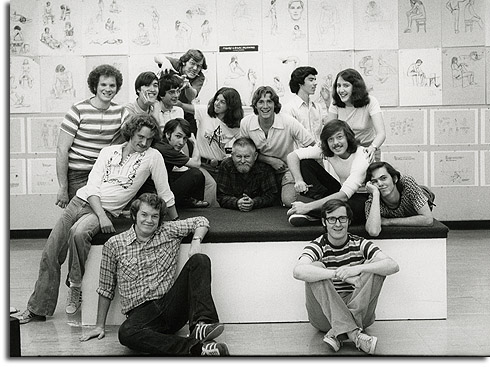Waking Sleeping Beauty is a film that, by all rights, shouldn’t exist.
After all, at its core it’s the story of massive egos maneuvering for control and credit in the wake of one of the Disney company’s most successful artistic and financial periods since Walt’s death in 1966. Getting any of the parties involved to reflect on those events with even a modicum of honesty or introspection would seem beyond the reach of even the most determined filmmaker – especially when two of those parties are named Michael Eisner and Jeffery Katzenberg. Yet that’s exactly what former Disney animation producer Don Hahn has done, combining archival footage with new interviews to craft a look at the rise of Disney feature animation from 1984 to 1994 that feels remarkably honest, authentic, and even-handed.
The arc of the story itself is well-known to fans: the fortunes of Walt Disney Productions’ animation unit were at their lowest ebb in 1984 when new management arrived at the company. Ten years later, Disney released the most successful animated picture ever to that point – The Lion King – and was on top of the film world. Waking Sleeping Beauty shows what happened in between, and how the moribund animation division went from teetering on the edge of closure to lavish bonuses, parking lots full of sports cars, and worldwide fame.
 The CalArts graduating class of 1975 included many prominent future animators. Back row: Joe Lanzisero, Darrell Van Citters, Brett Thompson, John Lasseter, Leslie Margolin, Mike Cedeno, Paul Nowak, and Nancy Beiman. Center row: Jerry Rees, Bruce Morris, instructor Elmer Plummer, Brad Bird, and Doug Lefler. Front row: Harry Sabin & John Musker.
The CalArts graduating class of 1975 included many prominent future animators. Back row: Joe Lanzisero, Darrell Van Citters, Brett Thompson, John Lasseter, Leslie Margolin, Mike Cedeno, Paul Nowak, and Nancy Beiman. Center row: Jerry Rees, Bruce Morris, instructor Elmer Plummer, Brad Bird, and Doug Lefler. Front row: Harry Sabin & John Musker.The film begins in the early 1980s, with a look at the sleepy Disney lot where young animators seemed to be desperately looking for a creative outlet while the animation division spun its wheels in the morass of The Black Cauldron. The clips are downright eerie – animator Randy Cartwright’s home movies document the young faces of artists who would later become a “who’s who” of famous talent in the animation and filmmaking worlds. A very young Tim Burton appears, as do John Lasseter and Joe Ranft. A lot of the talent in that building would soon leave or be laid off; others would remain, working to keep the Disney legacy alive until someone gave them a chance to unleash their talents on something fresh.
One of the more interesting aspects of this film is how it presents the opposing sides of various conflicts, and actually helps the viewer at least understand the viewpoints of parties that are typically portrayed as antagonists. We witness the inevitable culture clash as Hollywood outsiders arrive to run the company, but in many ways the changes they made were necessary to give the production side of the company some sense of direction and control. A lot of disputes still fall into the grey area of history – The Black Cauldron is said to have been a shambles when the new management arrived, but Katzenberg’s first move was to cut out some of the darker moments from the film. This is depicted as a rather common-sense decision, but it would also seem to contradict any ideas about letting the young animators stretch themselves in new directions. In other instances, notably the decision to kick the animation division off the lot to clear up offices for celebrities with new production deals, management clearly went too far.
In many of these cases, whether they were tone-deaf memos or meetings gone wrong, there’s a remarkable amount of candid perspective from the executives themselves – former studio chief Jeffrey Katzenberg, in particular, seems to have mellowed considerably over the years.
The film’s arc follows these threads – the desires of the animators to keep topping themselves and to produce art clash with the constraints of corporate leadership and the new-to-Disney management styles of Katzenberg and Peter Schneider, who was brought in to act as President of Feature Animation. The film also shows the rise of marketing’s influence and some of the unfortunate effects thereof – notably the much-opposed title change from Basil of Baker Street to The Great Mouse Detective.
The film doesn’t necessarily dwell on the “artists versus the Man” aspects of the story; there’s a lot of conflict at the executive level as well. The tensions between Disney CEO Michael Eisner, Katzenberg, and animation Chairman and champion Roy E. Disney shaped the era in many ways, and what’s interesting is not necessarily the conflicts themselves but what they say about the parties involved and how they viewed the purpose of Disney animation. In the end, even if you disagree with their actions, I think one can see where the various factions were coming from. There’s a particularly fascinating bit where Hahn transposes archival footage from various interviews filmed in support of The Lion King’s 1994 release. As each executive tries to describe the film, they relate very different stories – each individual has projected the film’s plot through the lens of their own perception. It’s so telling, and serves as a wonderful summation of the story; as one animator is quoted as saying about The Lion King, the film they were making was about themselves.
I could talk forever about the fascinating insights of the film – for instance, the contributions that Howard Ashman made during his all-too-brief career at Disney, which are illustrated in wonderful excerpts from filmed story meetings and presentations. Ashman was no mere lyricist, but is shown to be a valuable contributor to the entire creative process behind the films on which he worked. Thankfully, the film also gives a great deal of credit and screen time to Disney President and COO Frank Wells, and it confirms what many have long expected – that it was his stable hand and disinterest in the spotlight that kept the potboiler of talent and ego at the studio at least somewhat in check until during this Golden Age. Wells was the buffer, and it was after his 1994 death in a helicopter crash that things really unraveled and began the long, downward slide that would follow. The footage from Wells’s memorial is quite touching, and one really does feel for Eisner who is obviously shaken and rather at a loss about what to do.
In the end, I suppose the best compliment I could pay to a film like Waking Sleeping Beauty is that I’d happily and gladly sit through ten more films just like it. It strikes the perfect balance between answering questions one might have had, and raising so many more that one can only hope that more tales from this period will eventually emerge. Each of the films covered in the span of this story, The Black Cauldron, The Great Mouse Detective, Oliver & Company, The Little Mermaid, The Rescuers Down Under, Beauty & the Beast, Aladdin, and The Lion King, could merit a documentary of their own showing the tortured creative process that led them from concept to screen. The true story behind the making of The Black Cauldron would be especially fascinating.
I’d also be glad to see more about the periods both before and after the events depicted in Waking Sleeping Beauty; the reasons behind the studio’s decline after Walt’s death have never been fully explored, and there are many, many tales to be told of the second great decline leading to the death of traditional animation at Disney in 2004.
Of course, the true stars of the show are the animators themselves and the seemingly endless amount of filmed material documenting their shenanigans gives a wonderful sense of what life was like at the studio in those days. I hope to see more of this material in the future; these behind the scenes glimpses of alternately bored and overworked animators and frustrated story artists tell us more about the films that resulted from their efforts than a thousand glossy DVD featurettes. The artists deserve to have their stories told, too, and of course there remains a great deal to be told about Roy E. Disney himself.
Waking Sleeping Beauty hits the sweet spot that I think will manage to please Disney fans, fans of animation in general, those who enjoy tales of corporate intrigue, and just about everyone who simply likes a good story, told well. Hahn and his co-producer Peter Schneider have done an excellent job in putting this film together, and I would love to see more from them in the future. If you can find this film playing near you, I highly recommend that you check it out; it’s also playing at a number of film festivals so watch the film’s official website for scheduling information.











I am so so jealous you got to see this. Your description of the film makes it sound like a grander scope prequel to “Dream on Silly Dreamer” (Which you need to see by the way! I stick it in the dvd player whenever I feel like a good cry.).
It’s very interesting to me that they were able to get perspectives from the executives. It’s not common to see someone spend much time trying to understand reasons behind the actions of say, Eisner.
And ugh…marketing and merchandising…the death of many things. (Ironic coming from a former merchandise designer ;)…..
Oh, and “FIRST!” …now second.
Thank you. I wish this documentary would make its way to Upstate NY or hopefully there will be a DVD. I knew I wanted to see this but now it feels like something I must see. I really appreciate the review.
You make me even MORE upset that I was out of town when it was showing. Here’s hoping it comes through again.
I saw the film last week in Chicago and its simply AMAZING..not only for the history of the company, but the insight and drama that happened during these years and what went into making these films is just CRAZY…I’m sure a DVD release will happen, hopefully with bonus materials of stories or details left out of the film…I agree, they should make a serires of films detailing the making of all these films…
To jump on what Celeste said about Dream On Silly Dreamer, that’s the documentary that answers:
“the reasons behind the studio’s decline after Walt’s death have never been fully explored, and there are many, many tales to be told of the second great decline leading to the death of traditional animation at Disney in 2004.”
If you’ve never seen it, I highly recommend. It’s available on DVD now. It may not have been done w/ the scope or depth of Waking Sleeping Beauty but it definitely touches on a lot of what you’re asking for and is well worth watching.
Michael, I agree with Celeste about “Dream On…” It is very sad.
But seriously, how was the popcorn?
Thanks guys – I hope everyone will be able to see this soon. I’m sure a DVD won’t be far behind, though.
And I’m looking forward to seeing Dream On Silly Dreamer…
[…] And now news from one of our local North Carolina Blogs it comes to us from Progress City USA. Michael Crawford at Progress City USA posts a review of Waking Sleeping Beauty, a film that we all must see. […]
[…] my original review of the film from its theatrical release, I said that it is rather remarkable that Waking Sleeping […]
[…] Crawford at Progress City, USA posts a review of Waking Sleeping Beauty, a film that we all must see. He also takes a ROUND-about look at the France […]